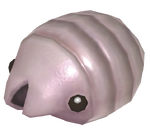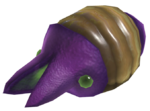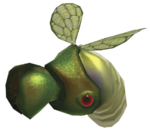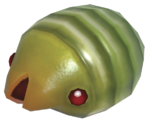Mandiblard family
|
To do: Do all members of this family, in all games, lose health if they touch water? Add the info here and on water. |
The mandiblard family consists of four known species, three of which demonstrate a degree of sexual dimorphism not uncommon to insects. On a whole they have little vitality and are not especially dangerous, but like the Cloaking Burrow-nit, they are infamous for tearing apart nearby stick bridges which Pikmin have built. Due to their general inability to present any danger, these enemies are usually found in groups of three or more, and are always buried in the ground, appearing only when a leader or Pikmin approaches close by.
The family's name comes from the word "mandible", and the names of the members derive from the word "shear". The sound they make when chomping down bridges sounds strikingly similar to a real world pair of shears closing.
Female Sheargrub
- Main article: Female Sheargrub.
Female Sheargrubs are a much lighter color than the males and have significantly smaller mandibles, making them unable to cause direct harm to a leader or any Pikmin, though they are still a menace to bridges. They can be ignored in most situations, perhaps only useful as a means of easy-access nectar, which they will produce if killed while petrified.
Male Sheargrub
- Main article: Male Sheargrub.
Male Sheargrubs have a dark purple shell and large mandibles. They are capable of attacking leaders and the Pikmin, but are not a serious threat, as they can only eat one Pikmin at a time. In Pikmin, when a Male Sheargrub has a Pikmin in its mouth, it is invulnerable to most attacks and can only be defeated either after it has eaten its prey, or if another Pikmin is thrown directly onto its back. This was fixed in Pikmin 2, allowing players to kill them by any method even if they have a Pikmin in their jaws.
Shearwig
- Main article: Shearwig.
Shearwigs are enemies in all three Pikmin games. The females of this species are never seen, as they spend nearly their entire life underground. The males have a dark green shell, sporting simple wings and large, sickle-shaped mouthparts. They are slightly more aggressive than Male Sheargrubs and will fly to safety when their health reaches half; up in the air, they regain health. One well-aimed Pikmin will bring a flying Shearwig down for good. Both Sheargrubs and Shearwigs will drown quickly in water, so luring them into a pool is an alternative strategy. Shearwigs deal the most damage to leaders out of any enemy in Pikmin 2.
Swarming Sheargrub
- Main article: Swarming Sheargrub.
Official family unknown
Swarming Sheargrubs are a green subspecies of the mandiblard family, quite similar to the Female Sheargrub. They are found only in Pikmin 3, usually in groups of six to eight. They can drink nectar to increase in size and weigh objects down. When attacked, the entire group goes into a panic and scatters. Swarming Sheargrubs can't attack the player or Pikmin, making it the second member of this family to be completely harmless. It is unknown if they can eat stick bridges since the bridges in Pikmin 3 are made of clay Fragments. Their mandibles are shorter and stubbier than a Female Sheargrub's, but only by a little bit.
Trivia
- In Pikmin, all mandiblards share the same internal name, "Kabekui". "Kabe" means "wall" and "kui" meaning "pile". The name "wall pile" could refer to their bridge-eating ability.
Name in other languages
| Language | Name | Meaning |
|---|---|---|
| Mandibulards | Mandiblards |



